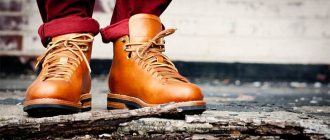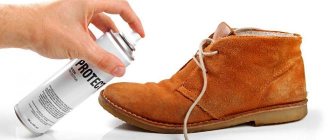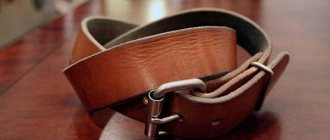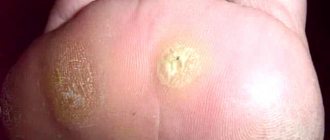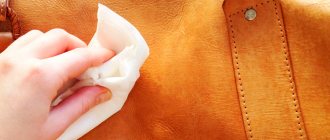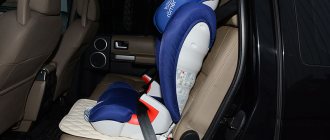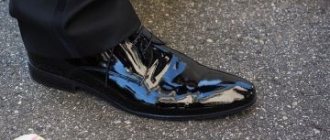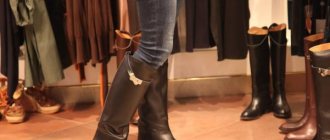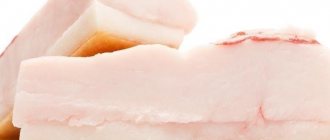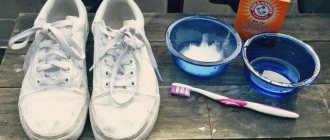How to soften shoes made of natural suede?
Ways to stretch suede shoes
Houses
Water. Wipe the inside surface with a damp cloth and put it on a cotton sock, repeat after drying. Steam. Hold your shoes
over boiling water until slightly warm and wear with a sock, repeat if necessary.
Interesting materials:
Is it possible to make a U-turn at an intersection in reverse? Is it possible to grow juniper at home in a pot? Is it possible to grow fir in a pot? Is it possible to grow a ficus from a branch? Is it possible to grow Ficus rubber from a leaf? Is it possible to embroider on Annunciation Day? Is it possible to embroider during Lent before Easter? Is it possible to embroider on religious holidays? Is it possible to embroider during Holy Week? Is it possible to embroider on Palm Sunday?
Why do shoes rub your feet?
Everyone, at least once in their life, has bought shoes that, when worn for a long time, caused a feeling of discomfort. Even the most expensive shoes made of genuine leather can cause its owner a lot of inconvenience, causing calluses and unbearable pain.
Hard shoes cause discomfort to the owner, causing calluses and severe pain.
The main reason for the stiffness of new shoes is the low quality of the product. A bad last or improper tailoring provokes inconvenience, discomfort, and an unattractive gait.
But not only new shoes can turn into a real disaster for their owner. During wear, some leather models also become rough and hard. The cause may be exposure to dirt, water, sweat, as well as improper drying, for example, on a radiator or heater.
Is it possible to return (change, return)?
According to the current legislation of the Russian Federation, two types of guarantee apply to purchased shoes:
- Exchange guarantee;
- Quality assurance.
This is interesting: If shoes made of natural or artificial suede are small, how to stretch them
In the first case, this means that within 14 days from the date of purchase you can contact the store and ask to exchange the product for a more suitable one. Possibly with an additional charge. This can be done if the product does not fit you in size, you are not satisfied with the shape, style, color, or the package is incomplete.
Important! In addition to the product itself, you need to have its packaging and a receipt confirming the fact of purchasing the shoes. In addition, all factory tags must remain intact. Quality guarantee means that the client can return a product that was found to have a manufacturing defect
In this case, an examination is appointed, during which the causes of the defect are determined. If it really is the manufacturer's fault:
The quality guarantee implies that the customer can return a product that has been found to have a manufacturing defect. In this case, an examination is appointed, during which the causes of the defect are determined. If it really is the manufacturer's fault:
- The consumer is provided with another pair of shoes, but of appropriate quality;
- Or repairs are carried out free of charge.
The seller has 20 days for this.
After the specified period, in the absence of any action on his part, the buyer has the right to a refund.
You can take advantage of this opportunity if you suddenly discover after the purchase that:
- Paint is falling off shoes;
- The sole has come off or worn out (if the shoes have been worn for no more than 3 months);
- The seams are broken.
Attention! Only shoes that have retained their salable condition are accepted for return, repair or exchange. You will not be able to use the guarantee if you:. You will not be able to use the guarantee if you:
You will not be able to use the guarantee if you:
- The shoes were damaged in the process of self-repair (only replacing the heels and gluing a preventive outsole is allowed if this does not result in defects);
- The product was worn in conditions not intended for this purpose (out of season);
- The product was accidentally damaged in some other way during use.
Therefore, try to handle the product as carefully as possible until you finally understand whether it suits you. Otherwise, all you can do is give it as a gift to someone or resell it.
Shoemaker tips
In order to avoid all sorts of problems associated with rubbing shoes, follow a few simple recommendations when choosing them:
- Don’t rush to buy the first pair you come across, even if, at first glance, it fits your feet perfectly. Walk around the store in it for a couple of minutes. Sometimes the feeling of discomfort does not appear immediately;
- You shouldn't buy a smaller model than you need just because it looks more attractive. During wear, the shoes will still not stretch to the size you need, but problems with the health of your feet are guaranteed to make themselves felt;
- Buying shoes that are more spacious than necessary is not protection against chafing. The material will also come into contact with the skin in unnecessary places, causing pain;
Pay attention to the quality of tailoring. On the inner surface of the shoe there may be protruding pieces of fabric, seams and other unnoticeable details that will make themselves felt during your first walk.
If you find them, it is better to refuse to buy a pair, despite its visual appeal; The best choice is products made from natural fabrics or leather with high-quality orthopedic lasts. They fit the leg well, leaving enough free space for comfortable wearing, and do not interfere with the access of oxygen. In addition, such materials stretch more easily, changing their shape if necessary and adapting to the physiological characteristics of your foot.
This is interesting: If the shoes are small and you need to quickly break them in, what can you do at home?
Remember that preventing the appearance of calluses is easier and better than getting rid of them later. And care when buying shoes is the first thing that is necessary for this.
How to choose ankle boots so they don't chafe
Using these methods, you will be able to break apart the ankle boots. But this will take some time, during which you will have to endure inconvenience. Choosing the right shoes will help reduce discomfort .
- When purchasing, try on a thick wool sock.
- If you don’t have such a sock when trying on, choose those that are 1 size larger than you need.
- Give preference to trusted manufacturers who will ensure the quality of materials and products as a whole.
Now you know how to stretch ankle boots, making them not only practical, but also comfortable to use. And most importantly, you can protect your feet from wounds, abrasions and abrasions even with prolonged use of the products. All the methods that we talked about were tested in practice and really helped in working with ankle boots. We hope your shoes become comfortable too!
Survival equipment: Tarpaulin boots. Kind words.
So, here they are, fresh, in person:
The advantages of kirzachs are as follows: - they are universally suitable. Naturally, I understand that there are no completely suitable shoes (that is, ones that are great both in the desert and at the North Pole). In the same way, there are special wearing conditions (mountain climbing and mountaineering, parachute jumping, leaving a wet torpedo tube, duck hunting in a swamp) and special shoes corresponding to them.
But if we talk specifically about such an “average tourist,” then kirzachi can solve almost all of his “problems.” You can walk in the forest and in the field in them, climb a little in the mountains (not Everest, of course), walk on wet soil, you can wear them from spring to autumn, you can take them on a trip alone. More on this below. - they are cheap.
I don’t know how it is in other towns, but in Novosibirsk you can buy them (new!) at a cost from 800 (according to advertisements on Avito) to 1300 (“fishing and hunting store”) rubles. At the same time, “normal” hiking sneakers cost from 2,500 rubles and more (and that’s if you’re even lucky), while various “cool” boots of some sort will cost even more, about twice as expensive as sneakers. And it’s not a fact that the period of their usual wear will be longer.
- they are highly durable. The top is a strong fabric impregnated with something rubbery; bottom – leather. The sole is strong, thick, nailed with fifty nails. Here, as they say, there is nothing to break at one moment. With normal care, you can be sure that in the morning they will not get wet, the soles will not fall off, the seams or any seals will not become loose. Naturally, they will also fall apart evenly, but this will be expected and predictable, and, in the latter case, they can be repaired on the go with improvised means.
The absence of any valves, “smart fabrics”, “insoles with artificial intelligence” and “microcompressors on Black energy for purging the heel area and piquant massage of the toes” leads to the fact that all this will not break down and will not turn into a problem. Boots bathed in a swamp will remain boots. - as a result, these are “killing shoes.” Not in the sense that they want to kill. You can do in them what is “expensive” or “sorry” to do in other shoes. I’m not in any way advocating treating shoes like a beast (I take care of mine and take care of them), but I don’t see the point in turning a trip into global saving of expensive equipment (“God forbid I get a sneaker wet or scratch a patent leather shoe!”).
Therefore, in these boots you can walk on stones, overcome fords and huge puddles, wade through thorns or windfalls. Yes, there is a lot more that is possible. At least put out a coal that fell out of the fire without fear of melting the sole in a second. When cutting through thick bushes, nothing will get caught in them or tear. The laces will never break or come undone at the most inopportune moment (and you don’t need to think about whether to take a supply of these laces with you, and how many, and which ones, and where to store them...), these laces will not be “overgrown” with a bunch of clinging plant seeds threatening to prick your finger when tying. - passable water resistance. Like all multi-element shoes, they slowly leak along the joints and seams.
But with normal care this happens slowly and does not cause any particular inconvenience. Obviously, standing in the river for half a day in them is not at all comme il faut, but going through several fords or a wetland is completely acceptable. In them you can simply walk on damp grass, soaked in morning dew or drenched in rain (and in sneakers?). - your feet “breathe” in them. Due to the leather bottom, the feet do not sweat, and, as a result, do not force others to urgently find a gas mask at the end of a hot day, and do not freeze when it is cold (don’t forget about warm socks).
By tucking the boot down, you can further improve ventilation. Naturally, when it’s hot, they’re a little hot, but your feet don’t burn like in an oven, and the specific “tarpaulin” smell isn’t that terrible. In the same way, there are no diaper rashes, no inflammations, or other rubbish that some tourists tend to complain about. In cold weather, they are warmer due to the fact that a boot with a tucked-in trouser leg retains more air than boots or sneakers.
— Molded and worn-in boots are practically not felt on the foot, and it is even easier to wear leather “to suit yourself” than synthetics. For example, I enjoy wearing them during all the dacha-garage-camping periods of my life, almost every day (except for “civilian” life, of course), and I feel them almost like house slippers. - they are tall and protect the leg (from water, thorns, pebbles, dust and dirt, insects) almost to the knee. - they can be put on quickly and easily.
It doesn’t matter what you need (to go “into the bushes” on wet grass at night, or to urgently run away from a forest fire) - you can put on boots even without socks in a few seconds, and get to work. This is faster than lacing or fastening something, especially with sleepy or shaking hands. — possibility of tuning. It is important. If desired, you can experiment with insoles and socks (foot wraps), sew on any additional elements you like, and remake the sole tread. For example, on one of the versions of my own boots, I completely cut off the “standard” tread. The boots became even more slippery (as expected), but also even softer, somehow gentle, it was extremely easy to drive and walk in them (the feeling of that “oakiness” that was still there disappeared). But the most important thing is that you can fit the usual and necessary NAZ into your boots.
Ways to soften shoes
Made from genuine leather
The supermarket sells many different products to soften hard skin. Well-known manufacturers produce creams and sprays for shoe care.
Before treatment, apply a spray to the damaged area. Then it is lubricated with cream. Factory products can be replaced with alcohol, but softening will take much longer.
To soften natural rough skin, do not treat it with sunflower oil. This will make her even tougher.
Shoes made of genuine leather lend themselves well to softening. You can use methods such as rubbing with Vaseline, vinegar solution, and kerosene.
You can try this method: cover the hard part of the shoe with a thick cloth and then tap with a hammer on the area that needs to be softened. Put on shoes and walk around in them; if the effect is not good enough, then repeat the procedure, but the main thing is not to overdo it.
PU Leather
The best way to soften such skin is to create a greenhouse for it. To do this, you need to moisten a cloth with water and wrap it around the box of shoes. Wait until the rag is completely dry.
You can use newspapers to soften:
- wet the crumpled newspaper;
- stuff your shoes tightly with it;
- leave for a while so that the newspaper dries well.
Heel counter
Sometimes shoes fit perfectly on the foot, but a hard heel prevents you from walking normally. The most common methods to soften it:
- Take a hammer and tap the shoe in and around the heel area. Carry out the procedure carefully so as not to damage the shoes. If the skin color is light or it is thin, then you need to tap through a dense material.
- Moisten the backs with vinegar. It will soften them well, but not everyone can tolerate its pungent smell.
- Purchase special softening products. However, this method will not save money.
- You can apply sunflower oil to the heel and leave it overnight if the shoes are made of artificial materials. During this time it should become softer.
- Sew or carefully glue a soft cloth to the back. It will protect the heel from friction with hard skin.
- Shoe departments sell special pads. They are glued on the inside to protect the heel from rubbing. But there is a drawback: with active walking, the pad can move out.
- Use special pencils. They will make the inside slippery, which will reduce friction.
- If none of the methods helped in the fight against a hard heel, then you should contact a workshop, perhaps they will find another solution.
Softening the skin inside
To soften the leather inside the shoe, you can use these tips.
- Moisten the inside of the shoes with alcohol, put them on and walk in them for about 2 hours. This will help soften stiff areas and also stretch small shoes.
- Rub the inside of the shoe with paraffin (a regular candle) and leave overnight. In the morning, remove excess product. The method will get rid of calluses.
- Stuff each shoe or shoe with wet newspapers. Allow to dry, but away from heating appliances.
- You can also try this unusual method. Pour water into the bags (¼ part), put them inside the shoes (boots), put the shoes in the freezer, let the water freeze, then take out the shoes and try them on.
Reasons for appearance
Calluses are thickenings of the skin layer that develop as a result of prolonged friction against a hard, rough surface.
Pathological phenomena may occur due to:
- wearing tight or uncomfortable shoes;
- the use of socks (stockings) made from low-quality synthetic fabrics, defective models;
- excessive sweating;
- increased ambient temperature;
- failure to comply with personal hygiene rules, contamination of the skin surface.
The appearance of corns and calluses can also be contributed to by the individual structure of the skin (too thick or too thin).
The most common places for calluses on the foot are:
- fingers;
- heels;
- plantar parts;
- lateral surfaces of the feet.
Boots for women, orthopedic and for special forces
There is an opinion that there are no special female models. In fact, this is only partly true. Among domestic military boots of this type, there really are no women's combat boots, but they are quite popular abroad. Often when shopping for NATO tactical boots, you may inadvertently purchase shoes marked “F,” which means women’s version. As a rule, such shoes are lightweight.
As for the prevailing opinion about orthopedic models, in this case we mean boots with orthopedic insoles that can be worn by people with flat feet. Children's models of ankle boots that include the word “orthopedic” are rather sandals that do not have lacing, designed to fix the foot in the correct position.
Glycerol
How to wear ankle boots in an unusual way? Many leather products are cared for with products that contain glycerin. It is considered an alcohol compound, but is not aggressive, so it is good for the skin. Natural leather softens and stretches under the influence of glycerin. More often than not, the product is much more effective than industrial shoe polishes.
Glycerin is applied to the area that is rubbing the skin and left until absorbed. It is also used to rub hardened areas on the surface of shoes. After absorption, wipe off the excess with a napkin while polishing the skin. The effect is visible immediately, the boots become soft and the skin becomes supple.
How to wear ankle boots? Softening the shoes can also be achieved with an ordinary candle. The cinder is melted and liquid wax is applied to problem areas.
Those who are trying to soften the skin in this way should know that it is impossible to apply only melted wax, because it is hot, which means it can damage the skin.
Wax with paraffin is applied a few minutes after melting. The dried substance is wiped with a napkin and polished.
How to wear leather combat boots if you don’t want to use special products? Use lard, it contains a lot of natural fats that are good for the skin.
It is important to use fresh lard and not salted lard, because salt will harm the material. Use a small piece to rub the roughened area, but you can rub the boots completely, then you won’t have to polish the boots for very long
Natural animal fat protects shoes from temperature changes and moisture.
Deodorant
This may sound strange to some, but shoes shouldn't smell bad. It should not emit any unpleasant odor at all, and any stench from shoes is only a consequence of the untidiness of its owner. Even if these are sports sneakers or combat boots. We change socks every time we take off and put on shoes and use hard desiccs. Buy any good solid disinfectant at the nearest supermarket (Adidas, Rexona) and smear your feet with it before putting on your socks. You can also “walk” with disinfectant on the insoles a couple of times. This will make it impossible for bacteria to live in this environment and, as a result, will remove any odor.
If you have already dirty your shoes, wash them, including with hydrogen peroxide. Nothing will come unglued, and all microbes will die.
Effective methods for improving anti-slip soles.
For ordinary streets they are not so spiky, don’t worry)
Felt, linen, flannel or sandpaper. A good option is to glue pieces of thick felt to the sole. But this is not always convenient, because this may make it inconvenient to walk: the evenness of the sole is disrupted. This requires skill. Flannel or linen in this case will be a good replacement for felt. As for the sandpaper, it must be fabric-based, but even then it wears out quite quickly and has to be changed frequently.
Capron. Old nylon tights are melted over a fire and liquid drops are applied to the sole so that they collect in small tubercles.
Sand on the sole will prevent slipping on ice. Therefore, it seems to me that the option of immediately applying glue to the sole and immediately sprinkling it with sand (which you can buy at a construction site or ask a janitor) will be the best option for solving the problem of slipping in winter. After applying the sand, you need to wait a day until the glue sets. If the sand wears off, just repeat this simple procedure. Sometimes the sole is even deliberately melted a little in a frying pan or baking sheet, and then placed on a sandy surface. The sand is imprinted into the sole, providing a long-lasting effect. But there is a risk of ruining the boot, so you have to do it skillfully.
Getting rid of hard heels
An ordinary paraffin candle or laundry soap will help soften the backdrops a little. Rub one of these products on the inside of the heel of your shoe and try walking. You can also soften the backdrop with vinegar, generously moistening the skin in the problem area.
Alcohol diluted with water in a 1:1 ratio will help make artificial shoe materials soft. Moisten the backdrop with it and “break” it with your hands. Before the procedure, make sure that there is no cardboard insert in the heels; if it gets wet, it will get wet and the shoes will lose their shape.
Softening the back of boots with a hammer - video
If your favorite shoes or new sneakers rub your skin, don’t worry. You can soften them at home. When choosing softening products, pay attention to the material from which the shoes are made. Choose the method that suits you and enjoy walking in your favorite shoes or sneakers!
Castor oil. Moreover, only the “heads” of boots, which are made of genuine pigskin, can be softened. The tarpaulin boot does not soften or stretch at all.
The skin should be thickly lubricated with castor oil until it stops absorbing it. And then pull it onto the block and leave it warm, or on your foot and walk around in boots.
It should be noted that the top of tarpaulin boots (the tarpaulin material itself, which is a special leatherette) is still resistant to shoe polish and can only be cleaned with natural wax.
Leather shoes are the most common and comfortable to wear. But hard boots or shoes that are impossible to wear are a huge problem. It happens that you have to refuse new shoes just for this reason. However, you can try to soften the skin with improvised means.
How to stretch boot tops at home?
A narrow boot is a serious problem that can also be dealt with at home:
- Professional shoe stretching products are sold in many company stores. The best of them: Salton, Salamander, Kiwi. The product is applied to the boot from the outside. Then boots are put on the terry toe and worn until the product is completely absorbed.
- You can rub the boot of a narrow product with castor oil, put it on and wear it until completely dry.
- The thick cream should be applied to both sides of the boot, a plastic bottle with warm water should be placed in the boot and left overnight.
- The top of leather boots can be stretched by pouring boiling water over it and putting the boot on your foot.
- You can try stretching the boot tops made of thick leather using flannel fabric and an iron. To do this, you need to straighten the boot and place the boot (unbuttoned) on the ironing board. Thoroughly steam the boots through a damp flannel cloth.
Softeners
There are many different products available to soften hard leather on shoes. The following can be distinguished:
- A shoe workshop where specialists stretch shoes on special lasts and beat off hard spots with various devices.
- Professional creams and sprays for shoe care. It is advisable to apply them immediately after purchasing shoes.
- Folk remedies. This is something that can be found in a home medicine cabinet or in the kitchen. Let's look at the most effective softening methods at home.
Cleaning the boots until they shine
Military personnel are especially sensitive to the appearance of their own shoes.
Great attention is paid to caring for her. Both on weekdays and on holidays, ankle boots should look great. Let's get acquainted with the methods used to bring boots into a formal look
Let's get acquainted with the methods used to bring boots into a formal look.
Preliminary process
Before cleaning shoes, you need to prepare the tools you will need, the place of work and the boots themselves.
You will need the following:
- cleansing cream;
- soft and hard brushes;
- soft cloth for polishing;
- water.
Additionally, an old toothbrush, ear sticks, a lighter, and a cloth for moistening with water (or cotton wool) are used.
The workplace also requires specific preparation, because the process itself is slow and does not exclude accidental contamination of furniture and the interior in general:
- lay newspapers on the floor or lay down old oilcloth to keep the floor clean;
- for comfort, take a chair or stool - while squatting, you will want to take some steps faster, and quality will suffer as a result.
Berts also need to be prepared:
- First of all, remove the laces.
- Now work on the boots. They need to be washed thoroughly. This does not mean that it is necessary to bathe them in a body of water. The optimal solution is to clean them with a brush soaked in water at home temperature. Detailed treatment of each area to remove dust and dirt will help ensure a high-quality result for shoe care.
- After drying the boots, we begin to apply the cream.
Important! All work is carried out from the outside; moisture should not get into the space inside the boots. If such a problem occurs, dry your shoes using a specialized dryer. In the absence of it, baby powder is poured into the middle, which will dry out and remove the aroma from wearing shoes.
As an option, fill your boots with newspapers, they will absorb moisture
In the absence of it, baby powder is poured into the middle, which will dry out and remove the aroma from wearing shoes. As an option, stuff the boots with newspapers; they will absorb moisture.
Working stages
Classic shoe cleaning, or the most ascetic method gradually:
- Lubricate the dried boots with a compacted layer of cream;
- leave to absorb and dry for 10–15 minutes;
- take a soft rag in two hands;
- Use a cloth to polish your shoes with intense movements from side to side;
- leave them for ten minutes;
- To consolidate the result, apply the cream one more time;
- Now polish your shoes until they shine like a mirror.
Important! An excellent fabric for polishing is wool suiting or dress fabric. A piece of a thin blanket, perhaps a soldier's, or a strip from a thin officer's overcoat is suitable. It would be great to use a velvet fragment
It would be great to use a velvet fragment.
There are more labor-intensive methods - with water, with fire, but the amazing result after using them speaks for itself.
In the following method of cleaning shoes, water plays the first violin:
- Apply the first layer of cream and let it absorb;
- using a cloth soaked in water, rub the cream layer;
- apply a further layer and rub it in with water one more time;
- then repeatedly spread the cream on the shoes and polish with a wet cloth.
If everything is done correctly, with each subsequent layer the shine should increase to a mirror finish. The process involves applying two thick and several light layers of cream.
The stages of wet influence on boots should alternate with their mandatory drying in natural conditions.
Important! Rubbing the product should not be done quickly and thoroughly, from toe to heel. An additional option, which takes a lot of time and patience, but instead you will definitely get ankle boots with a mirror shine:. An additional option, which takes a lot of time and patience, but instead you will definitely get ankle boots with a mirror shine:
An additional option, which takes a lot of time and patience, but instead you will definitely get ankle boots with a mirror shine:
- tilt or turn over a jar of cream (metal only!) over a lighter and set the product on fire;
- quickly return the jar to its original position so as not to stain anything;
- let the contents burn for a couple of seconds until partially melted, and then close the lid - the fire will go out;
- Using a wet cloth, apply thin layers of softened cream until a good result is obtained;
- Warm the very finishing layer applied to the boots with a warm stream of a hairdryer or walk over it with the fire of a candle (lighter), and after 15 minutes, use control polishing by rubbing an additional layer with a wet rag.
The history of the appearance of army combat boots
Specific military boots appeared relatively recently - during the Second World War. They were invented by the German military for the needs of their paratroopers. Since paratroopers often broke their legs while jumping in their boots, new boots with high lace-up tops were developed for them. It was they who were destined to become the prototype of the first models of ankle boots.
After the paratroopers, the new shoes were appreciated by Wehrmacht officers, and after the end of the war, the American army paid attention to them. However, it took about 12 years before US Army soldiers began to change into new high boots with laces and strong soles
However, it took about 12 years before US Army soldiers began to change into new high boots with laces and strong soles.
The process of changing uniforms in the United States continued from 1957 to 1960, but the European NATO armies began changing their shoes immediately after the end of the war.
In the USSR army, the first models of new shoes with high tops were considered a symbol of the “decaying West.” Several attempts were made to replace the “kirzachi” with more comfortable shoes, but this caused great indignation among the general staff.
However, the Russian army still uses rubber and tarpaulin boots, as well as felt boots, along with footwear such as ankle boots.
Standard combat boots of the Russian Armed Forces are not capable of providing complete protection from moisture and frost, and no one will buy models for 9-12 thousand rubles for ordinary Russian soldiers.
However, many special forces and even mercenaries sell or take home their authorized military boots, in return buying the best models from famous manufacturers. Every year more and more Russian army servicemen do this.
Starting from the second half of the 1990s, the military style appeared, and tactical combat boots began to be in demand among the following categories of the civilian population:
- Hunters;
- Rybakov;
- Tourists;
- Representatives of youth subcultures.
Currently, ankle boots are produced at many specialized enterprises around the world.
